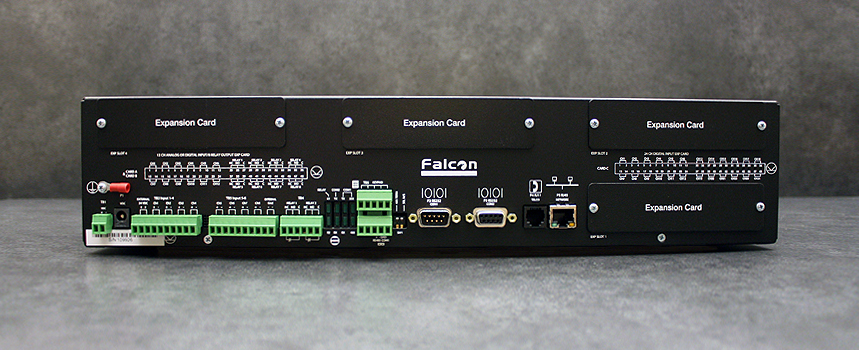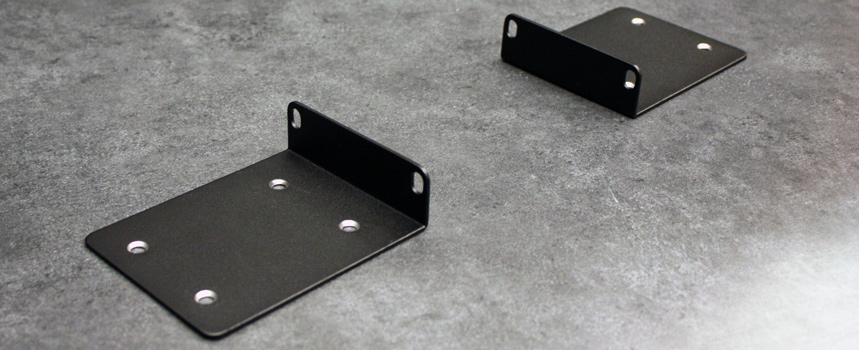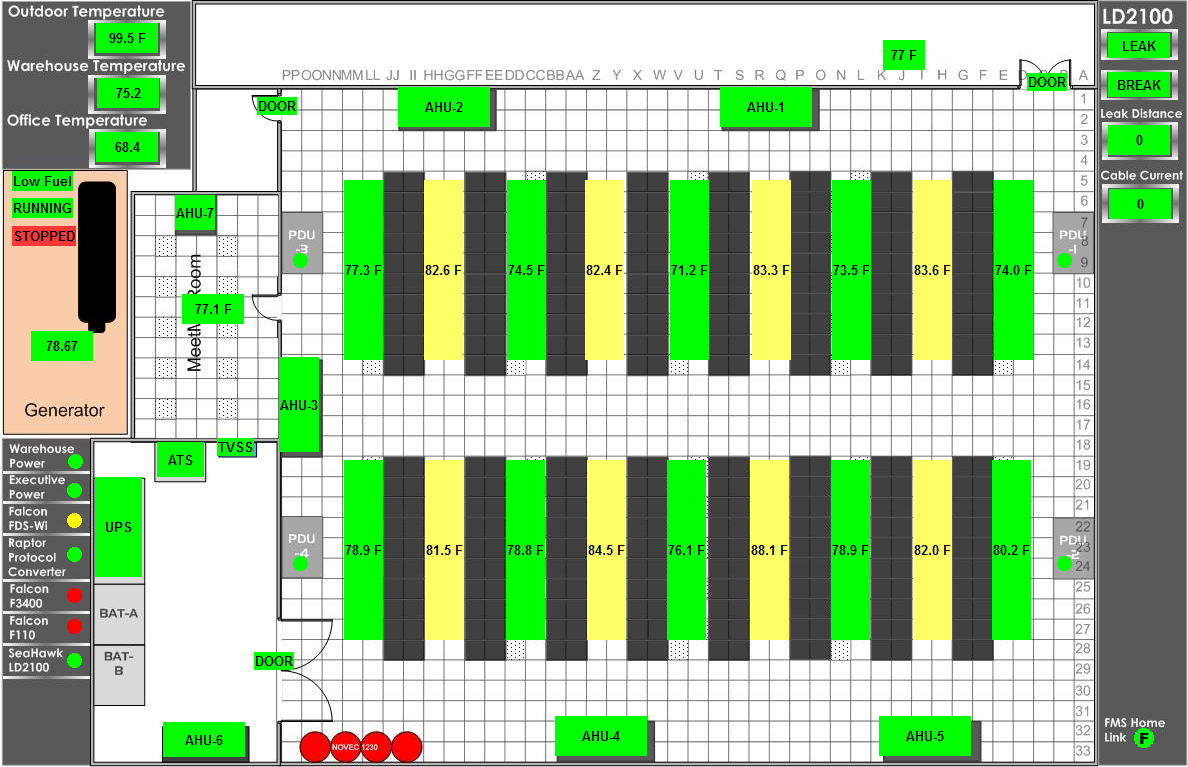RLE’s Facilities Monitoring System (FMS) is a comprehensive monitoring system commonly used to monitor sensitive facilities, critical equipment status and temperature, and environmental sensors. Feature-rich and budget friendly, the FMS is used in data centers, labs, telecommunications facilities, museums, and many other facilities around the world.
A Stand Alone Solution For Every Facility
The FMS stores and displays all its own data and hosts its own web pages; you won’t need to buy additional servers or install software on your PC. Great onboard features include data trending and extended logging, interactive graphical facility mapping, PUE/DCiE monitoring, and nesting, which allows one FMS to report conditions from a large collection of related FMS units.
Unmatched Reliability
The FMS is engineered without any internal moving parts – no hard drive, no fans. This means no downtime, no lost data, and no scheduled maintenance.
Seamlessly Integrates Into BMS Or NMS
Designed to be vendor neutral, the FMS aggregates information from a wide variety of sensors and equipment and then displays it through an onboard web interface. Does your facility have a larger BMS? No problem – the FMS also allows aggregated data to be pulled to other systems, all without additional servers or software.
Free Firmware Updates
Firmware updates for RLE products are always free and are available on our website. Keep your device up-to-date and access new, expanded features and functionality by updating your device’s firmware with our latest release.
Key Features
Accessibility
- Stand-alone, Web-enabled appliance hosts its own web pages
- Provides one integrated view of all facility equipment
- Use a web browser to configure the system and view data
- Stores and displays its own data – no additional servers or software required
- No recurring fees or setup fees
Reliability
- No internal moving parts, like hard drives or fans
- No downtime, no lost data
Easy Integration
- Third-party sensor friendly
- Vendor neutral
- Highly scalable
- Accommodates digital, analog, Modbus, and SNMP inputs
- Provides Modbus, BACnet, and SNMP output
- Multiple notification paths – SNMP traps, email, SMS/PDA
- Support for SNMP V1, V2, and V3
Specifications
Power
- 1U FMS: available as 24VDC or 48VDC –
24VDC Model: Input 24VDC 1A, Output 24VDC 300mA, power supply included
48VDC Model: Input 36-72VDC 0.5A, Output 24VDC 300mA
- 2U FMS: available as 24VDC or 48VDC –
24VDC Model: Input 24VDC 3A, Output 24VDC 300mA, power supply included
48VDC Model: Input 36-72VDC 1.5A, Output 24VDC 300mA
Inputs
- Analog/Digital: 8 Configurable as 4-20mA (12-bit A/D conversion) or Dry Contact NO/NC
- Internal Temperature/Humidity: ±0.5ºF (@ 25ºC), ±4ºF (@ -40º to 185ºF); ±3%RH (@ 20% to 80%RH); (Internal Temperature/Humidity optional)
- Keypad: Standard 3×4; 3000VAC RMS optically isolated; 20 User Access Codes (also accessible via phone/DTMF through modem)
Outputs
- Relay: 2 Dry Contact, Form C, 1A @ 24VDC, 0.5A resistive @ 120VAC (controllable via user programmable logic)
- Sensor/Accessory Power: 24VDC (±10%) @ 300mA max. (power for external sensors and/or devices)
Expansion Cards
1U accommodates 1 expansion card; 2U accommodates up to 4 expansion cards
24V Falcon requires EXP-x-24 option cards; 48V Falcon requires EXP-x-48 option cards
- EXP-A-24/48: 12 analog inputs (jumper selectable for 4-20mA, 0-5VDC or 0-10VDC) or digital normally open dry contact inputs (normally open ONLY!; non-isolated, individual ground only); 8 Form C Relay Outputs, 1A @ 24VDC, 0.5A resistive @ 120VAC. 48V FMS can accept only 1 EXP-A-24/48 card.
- EXP-C-24 or EXP-C-48: 24 digital normally open or normally closed dry contact inputs, 3000VAC RMS optically isolated (common ground or individual ground)
Communication Ports
- Ethernet: (RJ11 Telco; optional) 10/100BaseT, RJ45 connector; 500VAC RMS isolation
- RS-232: DB9 female connector; 9600 baud; 3000VAC RMS optically isolated; 15kV ESD protection
- EIA-485 (selectable as RS-232): Two-wire half duplex; terminal block (selecting RS-232 switches to DB9 male connector); 1200, 2400, or 9600 baud configurable; 3000VAC RMS optically isolated
- Modem: V.34bis/33.6 kbps; DTMF capable; PPP-enabled; FCC Part 68 approved; 1500VAC RMS isolation barrier; 2100V peak surge protection)
Protocols
- TCP/IP; UDP/IP; ICMP/IP; FTP; NTP; HTTP/HTML; SNPP; Telnet: IPv4; 1.1/4.0; up to 10 URL links to other IP addressable cameras/devices; webpages comply with Rehabilitation Act of 1973, sections 504 and 508, US Dept. of Education (website accessibility for computer users with disabilities).
- SNMP: V1: MIB-2 compliant; NMS Manageable with Get, Set, and Traps; V2c: Traps or Informs: V3
- SMTP (email): Supports Client Authentication (plain and login); compatible with ESMTP Servers
- Modbus: RTU transmission protocol; function codes: Server – 03; Client – 01, 02, 03, 04
- Modbus/IP: Modbus Server; TCP/IP transmission protocol; Reads up to 628 registers and converts to SNMP and BACnet
- BACnet/IP: Reads up to 106 instances and converts to SNMP and Modbus
- Terminal Emulation: VT100 compatible
- TAP (Pager): Telocator Alphanumeric Protocol v1.8
Alarm Notification
- Pager (Modem) – Optional: 15 text, numeric, or alphanumeric pager numbers; each digital and analog alarm (HighLimit and LowLimit) can notify any 5 of the 15 pagers
- Email (Ethernet, Modem PPP): 8 email recipients; email sent on Alarm and Return To Normal; each alarm can notify any or all of the 8 email recipients
- SNMP Traps (Ethernet): V1 and V2c: 8 Community Strings; V3: 4 users, 4 Trap Destinations
- Escalation: Additional notification to 1 of the 15 pager numbers when the initial page results in a Failure To Acknowledge status
Health Check/Self-Monitoring: Self resetting; captured in Event Log
Internal Hardware
- Real Time Clock: Battery backed; ±1.53 min/month accuracy
- Memory: 16MB RAM; 128K NVRAM; 16MB Flash
Logging Capabilities
- Alarm Log: Last 256 Alarms
- Event Log: Last 100 Events (e.g., Acknowledgement By Code, System Boot, Page Successful, etc.)
- Web User Access Log: Last 100 HTML Accesses (User, Date, and Time)
- Digital Status Log: Last 100 Digital Status entries
- Trending of Analog Inputs: 244 entries per time frame, per channel. High, low, and average values logged over specific minutes, hours, and days.
- Extended Trending (Analog Inputs): 3,840 entries over 32 inputs, physical or over Modbus. Logging at defined, user-selectable intervals.
Login Security
- Web Browser Access (Ethernet, Modem PPP): 1 Administrator plus 7 users individually selectable for Read Only, Read/Write or Administrator
- Terminal Emulation Access (Modem): 1 Administrator (password for Modem access)
Front Panel Interface: 1 on/off power switch. Red and green LEDs indicate status, network link, network activity, and modem activity
Operating Environment
- Operating temperature: 32° to 158°F (0° to 70°C).
- Humidity: 5% to 95% RH, non-condensing
- Altitude: 15,000ft (4,572m) max.
- Storage temperature: -40º to 185ºF (-40º to 85ºC)
Dimensions and Weight
- 1U FMS: 16.8″W x 1.8″H x 7.9″D (427mmW x 46mmH x 201mmD); 6 lbs. (2.72kg)
- 2U FMS: 16.8″W x 3.5″H x 7.9″D (427mmW x 89mmH x 201mmD); 10 lbs. (4.54kg)
Mounting: Rack mount (brackets included) or wall mount (brackets available, sold separately)
Certifications: CE; ETL listed: conforms to UL 61010A-1, EN 61010; certified to CAN/CSA C22.2 NO. 1010.1; RoHS compliant
Product Documentation Links
Technical Resources
Technical Notes
If you have an older, buff-colored FMS, it’s time to upgrade. As of July 1, 2016, we will no longer provide free support for these older discontinued FMS units. Paid support will still be available after the July 1, 2016 date at a rate of $125/hour.
Keep your FMS firmware up-to-date – the latest functionality and updates are just a click away!
Did you know FMS firmware updates are available online, and best of all, they’re FREE! Click on the downloads tab to find the latest version of firmware, and refer to the user guide for complete firmware update instructions.
FMS/F200 Nest and Egg Monitoring
Now it’s even easier to monitor the F200 as an egg in an FMS nest. Both the FMS firmware and the F200 firmware must be updated in order for the F200 egg feature to be completely functional: the FMS must be running firmware version 8.8.12 or newer, and the F200 must be running firmware version 3023, build 1420 or newer.
Downloads
Videos









